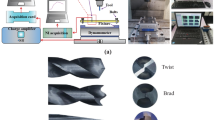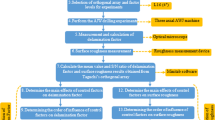Abstract
This paper presents an evaluation of hybrid cryogenic processes used to eliminate burrs on the exit side of drilled holes in carbon fiber-reinforced plastic composites. These hybrid cryogenic processing methods do not produce environmental hazards and they involve adding a longitudinal ultrasonic motion to the drill cutter and water into a cryogenic environment during the deburring process. There are four methods used for this hybrid cryogenic deburring process: the first method involves ultrasonic vibrations and a cryogenic environment; the second method involves water and a cryogenic environment; the third method involves water, ultrasonic vibrations and a cryogenic environment; and the fourth method involves water, ultrasonic vibrations, a cryogenic environment, and a backup ice layer. The methods were compared in terms of the percentage of removed burrs; the microscopy images of removed burrs are presented in this paper. According to experimental investigations, the fourth method exhibits up to 100% efficiency in removing burrs, followed by the third, the second, and the first method.
Similar content being viewed by others
References
Won SJ, Li CP, Park KM, Ko TJ (2017) The exit hole Burr generation of CFRP with ultrasonic vibration. J Korean Soc Manuf Process Eng 16(1):134–140
Cheng SK, Jeong SK (1999) Mechanical behavior of laminated composites using scrim prepregs for fishing rods. J Korean Soc Composite Mat 12(5):80–86
Park KM, Ko TJ, Yu Z, Kumaran ST (2017) A study on the removal of CFRP machining defects by various tool geometries. J Korean Soc Manuf Process Eng 16(4):16–23
Wang FJ, Yin JW, Ma JW, Jia ZY, Yang F, Niu B (2017) Effects of cutting edge radius and fiber cutting angle on the cutting-induced surface damage in machining of unidirectional CFRP composite laminates. Int J Adv Manuf Technol 91:3107–3120
Lee YC, Shin GH, Kwak TS (2015) Deburring technology of vacuum plate for MLCC lamination using magnetic abrasive polishing and ELID process. J Korean Soc Manuf Process Eng 14(3):149–154
Bae JK, Park HY, Kwon BC, Ko SL (2016) Determination of cutting conditions for an efficient deburring process using a new deburring tool. J Korean Soc Manuf Process Eng 15(4):109–117
Jeong YH, Yoo BH, Lee HU, Min BK, Cho DW, Lee SJ (2009) Deburring microfeatures using micro-EDM. J Mater Process Technol 209(14):5399–5406
Jia Z, Fu R, Niu B, Qian B, Bai Y, Wang FJ (2016) Novel drill structure for damage reduction in drilling CFRP composites. Int J Mach Tools Manuf 110:55–65
Islam MM, Li CP, Ko TJ (2017) Dry electrical discharge machining for deburring drilled holes in CFRP composite. Int J Precis Eng Manuf -Green Technol 4(2):149–154
Islam MM, Li CP, Won SJ, Ko TJ (2017) A deburring strategy in drilled hole of CFRP composites using EDM process. Alloys Compd 703:477–485
Pereira O, Rodríguez A, Barreiro J, Fernández-Abia AI, Lacalle LNLD (2017) Nozzle design for combined use of MQL and cryogenic gas in machining. Int. J Precis Eng Manuf -Green Technol 4(1):87–95
Faga MG, Priarone PC, Robiglio M, Settineri L, Tebaldo V (2017) Technological and sustainability implications of dry, near-dry, and wet turning of Ti-6Al-4V alloy. Int J Precis Eng Manuf -Green Technol 4(2):129–139
Bermingham MJ, Kirsch J, Sun S, Palanisamy S, Dargusch MS (2011) New observations on tool life, cutting forces and chip morphology in cryogenic machining Ti-6Al-4V. Int J Mach Tools Manuf 51(6):500–511
Özbek NA, Çiçek A, Gülesin M, Özbek O (2014) Investigation of the effects of cryogenic treatment applied at different holding times to cemented carbide inserts on tool wear. Int J Mach Tools Manuf 86:34–43
Kumaran ST, Ko TJ, Li CP, Yu Z (2017) Rotary ultrasonic machining of woven CFRP composite in a cryogenic environment. Alloys Compd 698:984–993
Xu JY, An QL, Chen M (2014) A comparative evaluation of polycrystalline diamond drills in drilling high-strength T800S/250F CFRP. Compos Struct 117:71–82
Niu B, Su Y, Yang R, Jia Z (2016) Micro-macro-mechanical model and material removal mechanism of machining carbon fiber reinforced polymer. Int J Mach Tools Manuf 111:43–54
Tsao CC, Hocheng H (2005) Effects of exit back-up on delamination in drilling composite materials using a saw drill and a core drill. Int J Mach Tools Manuf 45:1261–1270
Liu X, Jiang B, Wu X, Qiu CY (2014) Defects study on drilling of carbon fiber reinforced polymer (CFRP) laminates. Mater Sci Forum 800–801:61–65
Hocheng H, Tsao CC (2003) Comprehensive anaysis of delamination in drilling of composite materials with various drill bits. J Mater Process Technol 140:335–339
Funding
This work was supported by the Technology Innovation Program (10053248, Development of Manufacturing System for CFRP (Carbon Fiber Reinforced Plastics) Machining) funded by the Ministry of Trade, Industry & Energy (MOTIE, Korea).
Author information
Authors and Affiliations
Corresponding author
Rights and permissions
About this article
Cite this article
Park, K.M., Kurniawan, R., Yu, Z. et al. Evaluation of a hybrid cryogenic deburring method to remove uncut fibers on carbon fiber-reinforced plastic composites. Int J Adv Manuf Technol 101, 1509–1523 (2019). https://doi.org/10.1007/s00170-018-3045-z
Received:
Accepted:
Published:
Issue Date:
DOI: https://doi.org/10.1007/s00170-018-3045-z




